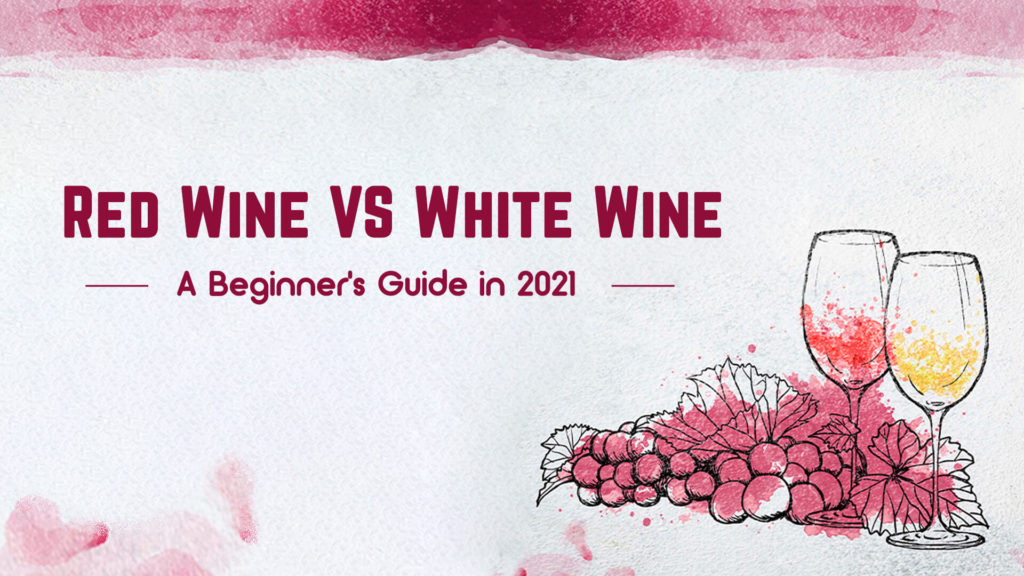Blog
Red Wine vs White Wine: A Beginner’s Guide in 2021
At first glance, it looks as though there is a multitude of differences between red and white wine. All those differently shaped bottles. The variety of names and languages that appear on the labels. All those distinct hues shining out when you buy alcohol online in Singapore. Where to begin?
It is true there is a plethora of differences between red and white wines, but these can be categorised under three main headings. Firstly, red and white wines are made from different grapes. Secondly, they are made from different parts of the grape. Thirdly, they are produced in different ways which give them different flavour profiles. Finally, their different taste profiles mean they pair with different foods.
Different Grapes
The fundamental difference between red and white wines is their colour. Red wines come from red fruit (sometimes called black grapes). Examples include Cabernet Sauvignon, Merlot, Pinot Noir, and Malbec. White wines are produced from white fruit such as Chardonnay, Riesling or Pinot Gris.
Red wines come in hues ranging from purple through ruby, garnet, and tawny to brown. The colour depends on the grape varietal used in production, the techniques used in the winemaking, the vintage, and the condition of the wine.
The same applies to white wines. They have a spectrum of colours ranging from lemon through green, gold, amber, and tawny. Again, it depends on the age of the wine, the grape, production methods, and its condition.
What is interesting is that wine-based spirits like brandy have a constant color – the hue is a pale to deep amber.
Different Parts of the Grape
The grapes are harvested, sorted, and brought into the winery to be loaded into equipment for the process of winemaking.
Another key difference between red and white wines is that different parts of each grape go into the production process. The standout difference is red wine is made by fermenting grapes with their skins and seeds. This allows for colour and tannin extraction which is what gives the wine and red hue and grippy mouth texture.
In order to minimise oxidation which can ruin a white wine in the production process very quickly, they are generally not fermented with their skins or seeds.
There are exceptions to this rule. In the case of particular aromatic varietals, a winemaker may allow some skin contact for a short time to add texture and flavour intensity to a vintage.
Different Production Methods
Think for a moment about when you are deciding between a red or white wine. What affects your decision?
We tend to appreciate red wines for their depth, tannic structure, texture, and body and white wines for their acidity and fruitiness. Red and white wines offer different tasting experiences. Achieving these results is down to treatment in the winery. To oxidise or not to oxidise is the question.
Too much contact with oxygen can spoil a white wine’s fragrant qualities. To retain the delicate aromas and flavours of these grapes, winemakers often use stainless steel tanks in production. In the cases where they use oak (which encourages oxidisation), it is because the aim is a woody note in the aromas and flavours of a white wine. However, many whites are unoaked so that their varietal personality shines through.
Red wines are another matter as most are enhanced by oak treatment. Oxygen helps stabilise phenolics, compounds that add to colour and ageing potential. Additional, tannins from the oak contribute to the wine’s structure. It is similar to the ageing process some whiskies undergo.
Food Pairing
When it comes to what food matches red or white wine, there are some basic guidelines worth keeping in mind.
Whites tend to go well with light, lean meats, fish, salads, and risottos while reds partner well with steaks, grilled meats, hard cheeses, and rich pasta dishes.
There are exceptions. For example, in Bordeaux, which is predominantly red wine country, they often pair un vin rouge with fish. Elsewhere, a nice acidic white can go well with a salty, red meat dish.
Colourful Creativity
The wine sector is full of creative people just like any other so you will see plenty of experimentation and crossover in wine colours. The grape known as Zinfandel in California and Primitivo in Italy is a red varietal. However, in California, there is a wine style called White Zinfandel which is not a red or a white but a rosé. Some producers have been experimenting with making white wines out of red varietals like South African Pinotage, Spanish Tempranillo, and Italian Sangiovese.
There is another colour category of wines worth knowing about which is connected to turning wine production methods upside down (in a good way!). These are known are Orange Wines and are so-called for their colour. Such wines, which you have likely seen when shopping for alcohol and liquor options online, are made entirely from white grapes but using traditional red wine production methods. In other words, they ferment with their skins. The result is orange-hued wine with a chewier texture and deeper body than a white.
Within the world of red and white wines, there are numerous differences from one bottle to the next. Keep in mind the basics of grape varietal, parts of grape and production methods firmly under your belt, and you will be well equipped to understand the main distinctions between the two categories. Santé!

